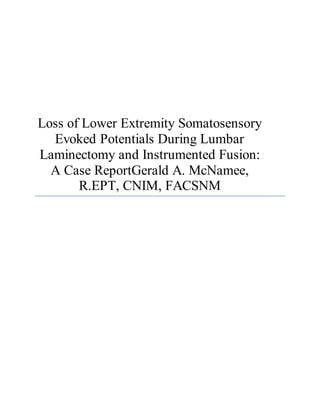A ORIGINAL-SSEPs and Lower lumbar surgery121314
- 1. Loss of Lower Extremity Somatosensory Evoked Potentials During Lumbar Laminectomy and Instrumented Fusion: A Case ReportGerald A. McNamee, R.EPT, CNIM, FACSNM
- 2. LOSS OF LOWER EXTREMITY SSEP DURING LUMBAR LAMINECTOMY ABSTRACT The utilization of lower extremity somatosensory evoked potentials (SSEP) for monitoring of lumbar surgical procedures remains controversial in the surgical neurophysiology community. The fact that multiple lumbar spinal nerve roots contribute to the SSEP prior to its transition into the posterior columns of the spinal cord may lead to insensitivity in monitoring these potentials. We present a case report of a patient undergoing a posterior approach, open, lumbar laminectomy and instrumented fusion. This patient experienced an acute loss of both cortical and subcortical posterior tibial nerve (PTN) SSEPs during lumbar laminectomy. Post-decompression testing revealed a full amplitude recovery of the attenuated evoked potentials forty minutes after loss of signal. An analysis of the case, literature review, and discussion on the merits of SSEP monitoring in these below-the-conus medularis procedures, is presented. Keywords: SSEP, Somatosensory Evoked Potential, Lumbar Spine Surgery, Surgical Neurophysiology, IONM
- 3. LOSS OF LOWER EXTREMITY SSEP DURING LUMBAR LAMINECTOMY CASE PRESENTATION A 55 year old male with a past medical history of two level lumbar laminectomy and lumbar stenosis presented for a L3/4 decompression and fusion with a revision lamino-foraminotomies at the left L4/5 and bilateral L5/S1. The patient complained of unprovoked, progressive, low back pain with radiation to bilateral lower extremities. The back pain is described as aching and stabbing in nature. The patient has difficulty standing any significant time or walking any significant distance. The patient presented conscious and fully oriented in no acute distress. There were no gross trophic changes noted. Sensation was grossly intact to bilateral lower extremity light touch. Strength testing revealed 5/5 (full strength) to bedside examination from the (a) quadriceps, (b) tibialis anterior, (c) gastrocnemius, and (d) extensor hallucis longus, bilaterally. There was no significant ankle clonus to acute dorsiflexion of either foot. Plain radiographs demonstrate a grade 1 spondylolisthesis at L3/4. Magnetic resonance imaging (MRI) revealed L3/4 spinal stenosis, left L3/4 and bilateral L5/S1 intervertebral foraminal narrowing. The conus medularis was noted at the L1 vertebral body level. The patient had no other significant medical history or allergies to food/medicine. Preoperative screening blood chemistry and lab results were unremarkable. The anesthesia regimen for this case included volatile anesthetics, narcotics, benzodiazepines, and neuromuscular blocking agents only to facilitate orotracheal intubation and surgical exposure. The surgical neurophysiology montage included bilateral ulnar and posterior tibial nerve SSEP and spontaneous electromyography (spEMG). EMG was collected from the Vastus Lateralis, tibialis anterior and abductor hallucis which reflected innervation from the L2-S1 spinal nerve roots, bilaterally. A Jackson frame was utilized for the procedure.
- 4. LOSS OF LOWER EXTREMITY SSEP DURING LUMBAR LAMINECTOMY Post-prone positioning baselines showed symmetrical and monitorable waveform latencies and amplitudes with clearly defined and consistent cortical and subcortical depolarization waveform morphologies. At 1015 a 3rd recording was run and all remained stable
- 5. LOSS OF LOWER EXTREMITY SSEP DURING LUMBAR LAMINECTOMY At 1031 there is a slight shift in the p37 latencies of the PTSSEPs. 1031 LT Post Tibial SSEP Shift in the p37 with stable PF
- 6. LOSS OF LOWER EXTREMITY SSEP DURING LUMBAR LAMINECTOMY At 1043 there is a loss of the Cortical PTSSEPs 1043 Loss of Left PTSSEP
- 7. LOSS OF LOWER EXTREMITY SSEP DURING LUMBAR LAMINECTOMY At 1046 the loss was confirmed and surgeon notified. At 1119 there continues to be a loss of the cortical PTSSEPs with preservation of the PF potential.
- 8. LOSS OF LOWER EXTREMITY SSEP DURING LUMBAR LAMINECTOMY At 1123 surgeon tells tech decompression is done and PTSSEPs return bilaterally. At 1202 Cortical PTSSEPs remained stable.
- 9. LOSS OF LOWER EXTREMITY SSEP DURING LUMBAR LAMINECTOMY At 1221 they started closing and a last trace was run with everything stable.









